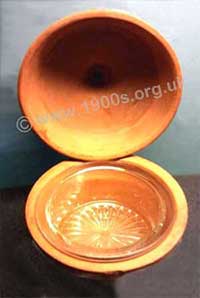Old methods for prolonging the life of food

In the past, perishable food was kept in the food safe because there were no fridges. Although this normally worked well, it did not always, either because the weather was particularly hot and humid or the personal hygiene was not what it should have been. Money was tight, ice would never have been bought by ordinary people and food was hardly ever thrown away. This page describes the ways that households used use to prolong the edible life of short-life food and food on the point of going bad.
____
Extracted from the memoirs of the webmaster's mother (1906-2002) and edited by the webmaster with further research and firsthand contributions from others
The butter cooler and milk cooler
The butter cooler or milk cooler was an essential item for every kitchen. It worked on the principle that evaporation causes cooling. The butter dish or milk jug was placed in the cooler dish which was kept wet. This was achieved firstly because the cooler dish was porous, usually terracotta (also known as earthenware or fired clay) and unglazed, so that it sucked in water, secondly because it was placed in a dish of water and thirdly because it was covered with a cloth that hung down into the dish of water, keeping both itself and the cooler wet. The cloth was usually crocheted to make it attractive as well as heavy, and beads were sewn round the edge to weight it down into the water.
Thus, whatever was inside the cooler was kept cooler than the outside room temperature.

Home-made butter cooler, crocheted from thick porous cotton thread, made wet and weighed down with beads. (It was easier to crochet a perfect round than to knit one.) The dish of water is not shown. Photographed in the Black Country Museum.
Flannel or muslin was sometimes used instead of the crochet cover. Another variation was a tall porous lid. Being tall it enabled the cooler to contain more food.

Commercial butter cooler and lid made of porous fired clay. The cooler dish was stood in the dish of water (not shown), so that it sucked up water, becoming damp and hence cool. The glass dish inside could be removed for the table.
However - and it was a big however, although these arrangements normally worked well, they did not when the weather was humid, like in a heat wave before a storm. Then the water wouldn't evaporate, so the butter or milk weren't cooled and they went off.
Then my mother resorted to other another measure for milk:
Scalding milk to stop it souring
In very hot and humid weather, when the milk cooler didn't work, my mother 'scalded' the milk to make it last longer. This involved heating it in a saucepan to near boiling point and letting it cool. Doing this wasn't ideal, though, because it took the substance out of the milk and made a skin form on top. I very much liked the skin but most people didn't. Also if the saucepan was not quite clean or if the heat was too fierce, the milk took on an unpleasant burnt taste.
Fortunately the dairy might make several deliveries each day in summer, but even so, I would sometimes be sent along to the dairy with a jug to buy more milk because what we had had gone sour.
Making scones with sour milk
It was common to hear women say that their milk had gone off so they must make scones. It was almost as scones were generally regarded as tasting better made with sour milk. I don't know how true this was, but I always liked our scones anyway.
Keeping meat edible with vinegar
Meat went off very quickly in hot, humid weather. Many a time I saw my mother wipe the Sunday joint over with a vinegar rag before cooking it because it was beginning to smell.

Meat, beginning to go rotten, being wiped over with vinegar before cooking
Using up stale bread
Stale bread was delicious in bread pudding, although if it was really hard, it had to be broken into lumps before cooking rather than slices. It was quite usual, incidentally, for people to eat heavy puddings for dessert, known at the time as 'afters'.
| sources | webmaster | contact |
Text and images are copyright
If you can add anything to this page or provide a photo, please contact me.



